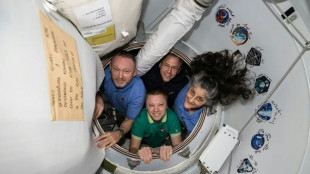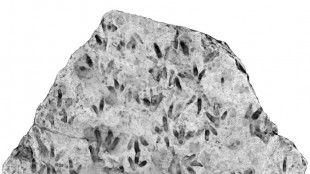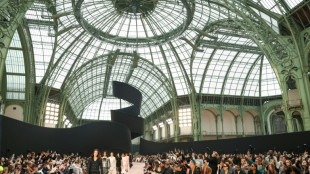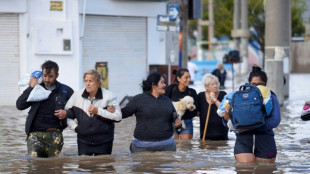
-
 Greenland to get new government to lead independence process
Greenland to get new government to lead independence process
-
Stocks diverge over Trump tariffs, Ukraine ceasefire plan

-
 Battery maker Northvolt files for bankruptcy in Sweden
Battery maker Northvolt files for bankruptcy in Sweden
-
Markets mixed as Trump trade policy sows uncertainty

-
 'Stranded' astronauts closer to coming home after next ISS launch
'Stranded' astronauts closer to coming home after next ISS launch
-
Thailand sacks senior cop over illicit gambling, fraud

-
 What to know about Manus, China's latest AI assistant
What to know about Manus, China's latest AI assistant
-
US tariffs of 25% on steel, aluminum imports take effect

-
 Trove of dinosaur footprints found at Australian school
Trove of dinosaur footprints found at Australian school
-
Rubio heads to Canada as Trump wages trade war

-
 Most Asian stocks drop as Trump trade policy sows uncertainty
Most Asian stocks drop as Trump trade policy sows uncertainty
-
Morocco fights measles outbreak amid vaccine misinformation

-
 Trump talks up Tesla in White House show of support for Musk
Trump talks up Tesla in White House show of support for Musk
-
Oil companies greet Trump return, muted on tariffs

-
 Trump burnishes Tesla at White House in show of support for Musk
Trump burnishes Tesla at White House in show of support for Musk
-
Italian defence firm Leonardo to focus on int'l alliances for growth

-
 Stock markets extend losses over US tariffs, recession fears
Stock markets extend losses over US tariffs, recession fears
-
Trump doubles down on Canada trade war with major tariff hike

-
 UK makes manslaughter arrest over North Sea ship crash
UK makes manslaughter arrest over North Sea ship crash
-
Ghana scraps IMF-linked 'nuisance' taxes

-
 Trump doubles down on Canada trade war with massive new tariffs
Trump doubles down on Canada trade war with massive new tariffs
-
French right-wing media's Russia tilt irks Elysee

-
 Stock markets waver after sell-off over US recession fears
Stock markets waver after sell-off over US recession fears
-
Volkswagen to navigate another tricky year after 2024 profit plunge

-
 Ships blaze after North Sea crash, govt rules out foul play
Ships blaze after North Sea crash, govt rules out foul play
-
Chanel plays with proportions as Paris Fashion Week wraps up

-
 Stock markets mixed as Trump-fuelled economy fears weigh
Stock markets mixed as Trump-fuelled economy fears weigh
-
Ships blaze, spill feared after North Sea crash

-
 Volkswagen profits hit as high costs, China woes weigh
Volkswagen profits hit as high costs, China woes weigh
-
Struggling Japanese automaker Nissan replaces CEO

-
 Ships still on fire after North Sea crash
Ships still on fire after North Sea crash
-
Lego posts record profit, CEO shrugs off US tariff threat

-
 Most markets in retreat as Trump-fuelled economy fears build
Most markets in retreat as Trump-fuelled economy fears build
-
Asian markets track Wall St lower as Trump-fuelled economy fears build

-
 From 'mob wives' to millennials: Faux fur is now a fashion staple
From 'mob wives' to millennials: Faux fur is now a fashion staple
-
South Korea's Kia denies responsibility for anti-Musk ad

-
 Kung fu girl group puts fresh spin on ancient Chinese art
Kung fu girl group puts fresh spin on ancient Chinese art
-
Asian markets track Wall St selloff as Trump-fuelled economy fears build

-
 Indian artisans keep traditional toymaking alive
Indian artisans keep traditional toymaking alive
-
Bear Robotics' Carti 100 Wins iF DESIGN AWARD 2025, Setting New Standards in Logistics Automation

-
 Formerra Introduces Formerra+ Upgraded Ecommerce Site to Optimize Customer Experience
Formerra Introduces Formerra+ Upgraded Ecommerce Site to Optimize Customer Experience
-
Search ends for missing crew member after North Sea collision

-
 One missing after cargo ship, tanker collide in North Sea
One missing after cargo ship, tanker collide in North Sea
-
Stock markets slump on US recession fears

-
 'Elbows up!' - the hockey tactic inspiring Canada's anti-Trump fight
'Elbows up!' - the hockey tactic inspiring Canada's anti-Trump fight
-
Argentina searches for baby, young sister swept away by floods

-
 Stock markets slump on US economic fears
Stock markets slump on US economic fears
-
UN chief says 'poison of patriarchy' is back with a vengeance

-
 UBS fined 75,000 euros in France for harassing two whistleblowers
UBS fined 75,000 euros in France for harassing two whistleblowers
-
Stock markets slump on US, China economic fears


Webb telescope captures 'breathtaking' images of Orion Nebula
The wall of dense gas and dust resembles a massive winged creature, its glowing maw lit by a bright star as it soars through cosmic filaments.
An international research team on Monday revealed the first images of the Orion Nebula captured with the James Webb Space Telescope, leaving astronomers "blown away."
The stellar nursery is situated in the constellation Orion, 1,350 light-years away from Earth, in a similar setting in which our own solar system was birthed more than 4.5 billion years ago.
Astronomers are interested in the region to better understand what happened during the first million years of our planetary evolution.
The images were obtained as part of the Early Release Science program and involved more than 100 scientists in 18 countries, with institutions including the French National Centre for Scientific Research (CNRS), Western University in Canada, and the University of Michigan.
"We are blown away by the breathtaking images of the Orion Nebula," Western University astrophysicist Els Peeters said in a statement.
"These new observations allow us to better understand how massive stars transform the gas and dust cloud in which they are born," she added.
Nebulas are obscured by large amounts of dust that made it impossible to observe with visible light telescopes, such as the Hubble Space Telescope, Webb's predecessor.
Webb however operates primarily in the infrared spectrum, penetrating the dust.
This revealed numerous spectacular structures, down to the scale of 40 astronomical units, or the size of our solar system.
These include dense filaments of matter, which could birth new generations of stars, as well as forming stellar systems that consist of a central proto-star surrounded by a disc of dust and gas, in which planets form.
"We hope to gain understanding about the entire cycle of star birth," said Edwin Bergin, University of Michigan chair of astronomy and a member of the international research team.
"In this image we are looking at this cycle where the first generation of stars is essentially irradiating the material for the next generation. The incredible structures we observe will detail how the feedback cycle of stellar birth occurs in our galaxy and beyond."
Webb is the most powerful space telescope ever built, boasting a primary mirror measuring 6.5 meters (more than 21 feet) that is made up of 18 hexagonal, gold-coated segments, as well as a five-layer sunshield the size of a tennis court.
A.Zimmermann--CPN
